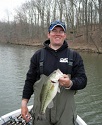 Some fishermen mistakenly seem to think fish are like bears and go into hibernation. Large game fish often turn up at this time of the year. The fish are not as aggressive when water temperatures are below 500-degrees. But they still eat and take a properly presented lure. In winter fish suck bait gently in leaving only the sensation of a tic on the line.
Some fishermen mistakenly seem to think fish are like bears and go into hibernation. Large game fish often turn up at this time of the year. The fish are not as aggressive when water temperatures are below 500-degrees. But they still eat and take a properly presented lure. In winter fish suck bait gently in leaving only the sensation of a tic on the line.
Any current in a body of water increases the oxygen content and fish relate to it. In general fish are in the 12 to 20-foot range this time of year. On larger impoundments without a warm water discharge the warmer water is in the section closer to dams. On main part of a lake the combination of structure and currents hold promise of good fishing. Fish tend to be just out of the current near structure. The forage fish are there picking up the small plankton that flows with the current. Bass in particular hang around the area close to stumps, beneath undercuts, rocks or just on a sharp breakline.
 Thawing periods increase river flow and current. The warming trend that occurs signals a feeding frenzy in predator fish. For some reason the larger fish are the first to react to the action. Often one will have to fish hard for a long time to get bites but the bites come from the larger fish.
Thawing periods increase river flow and current. The warming trend that occurs signals a feeding frenzy in predator fish. For some reason the larger fish are the first to react to the action. Often one will have to fish hard for a long time to get bites but the bites come from the larger fish.
Game fish like to hold on the edge of muddy water concealed from the forage fish so they can ambush them. The silt attracts the forage fish as it presents a source of food.
Disruptions such as noise on shore or in the water make the fish shut down. Light also seems to have an effect on the fishing action. The brighter the day the closer to the bottom the fish seem to locate.
Weedy areas or those with the dark bottom warm sooner and are areas likely to harbor fish. The weeds and the dark muddy bottom absorb what heat there is available on a sunny day and hold it longer than any other bottom structure.
Lures for ice-out fishing fall into two categories jigs and deep diving crankbaits. The rods should be very sensitive and the line very light test. The bite will be just a tic and therefore the light line and sensitive rod are required for the angler to know of the bite. One-piece rods are more sensitive than two-piece rods.
Fish all lures slowly. The lure needs to get down to the bottom or at least near the bottom. Crankbaits should slowly bounce along the bottom kicking up small clouds of mud. A loose wobbling crankbait that disturbs the silt on a branch or stump is more likely to attract the fish’s attention than one just passing over his head.
Because bait fish are just as slow reacting as are larger fish the crankbait needs to move in slowly. The idea is to make the crankbait imitate the action of the baitfish. That is to dart, slow down, and shimmy in one spot before moving off.
Continue reading this article at this LINK.…
—–
Join ODU Magazine on Facebook here at this LINK…..
Join ODU Magazine on our Twitter fishing site here at this LINK…..
Join ODU Magazine on our Twitter hunting site here at this LINK…..
.
